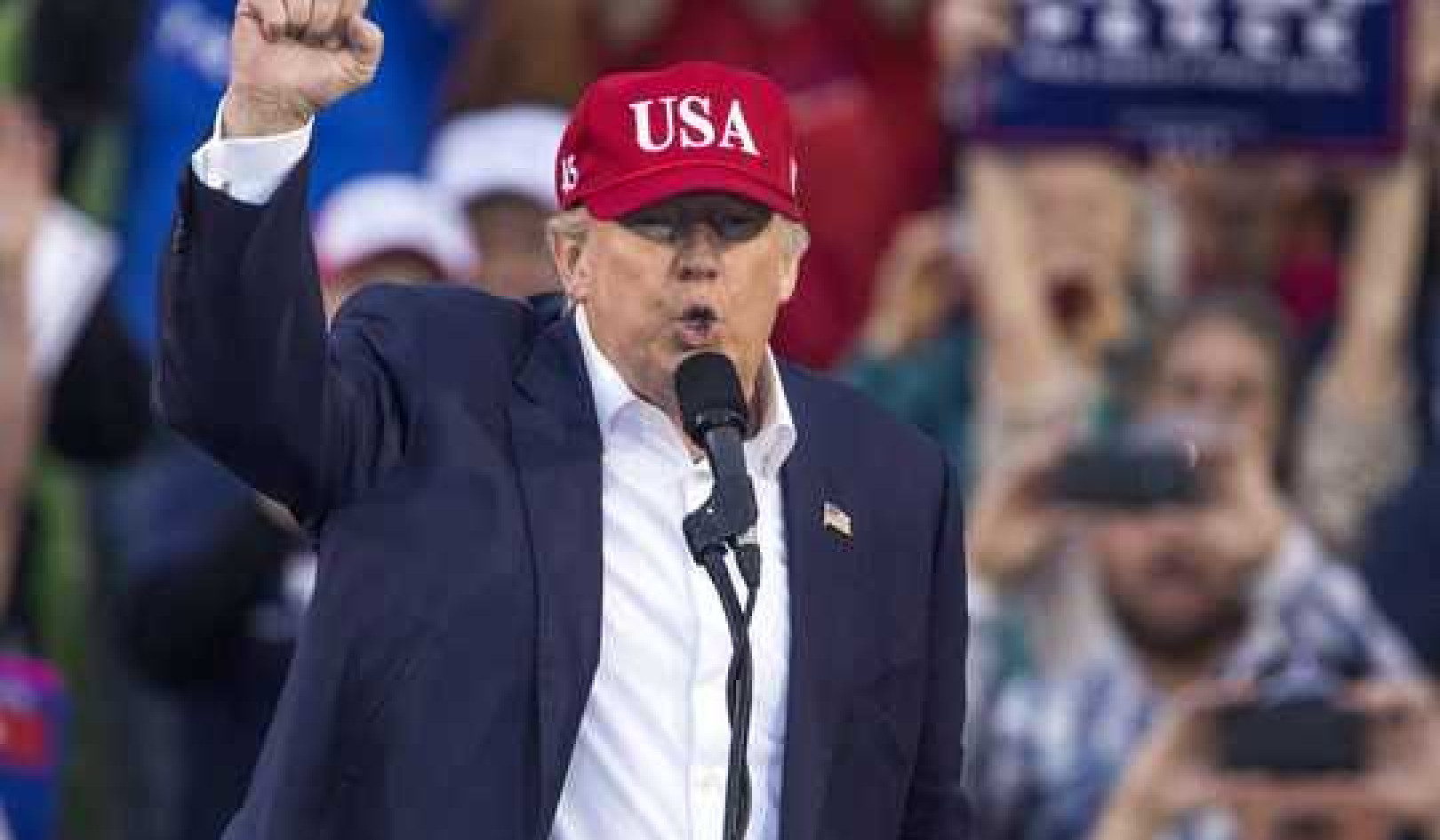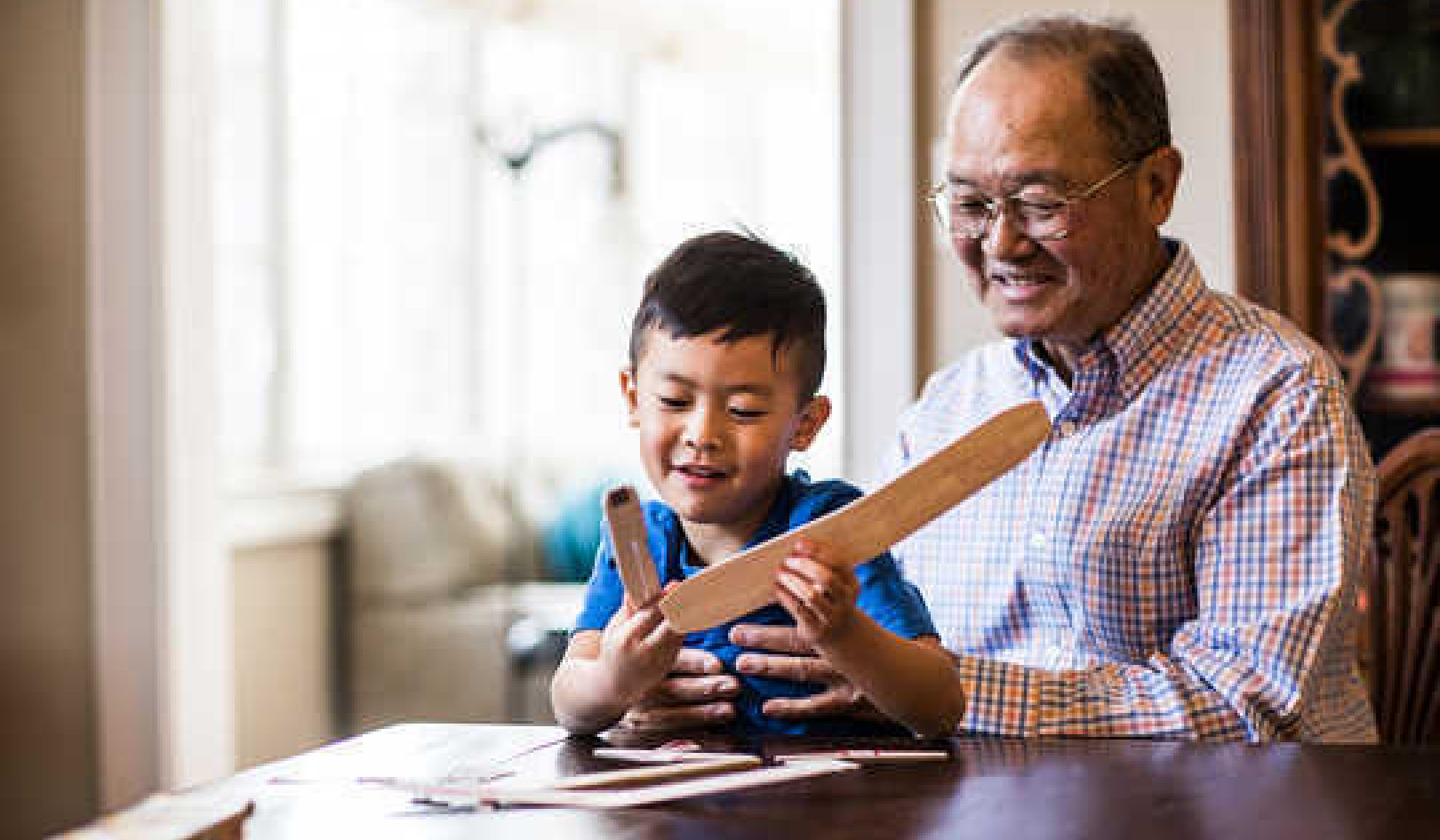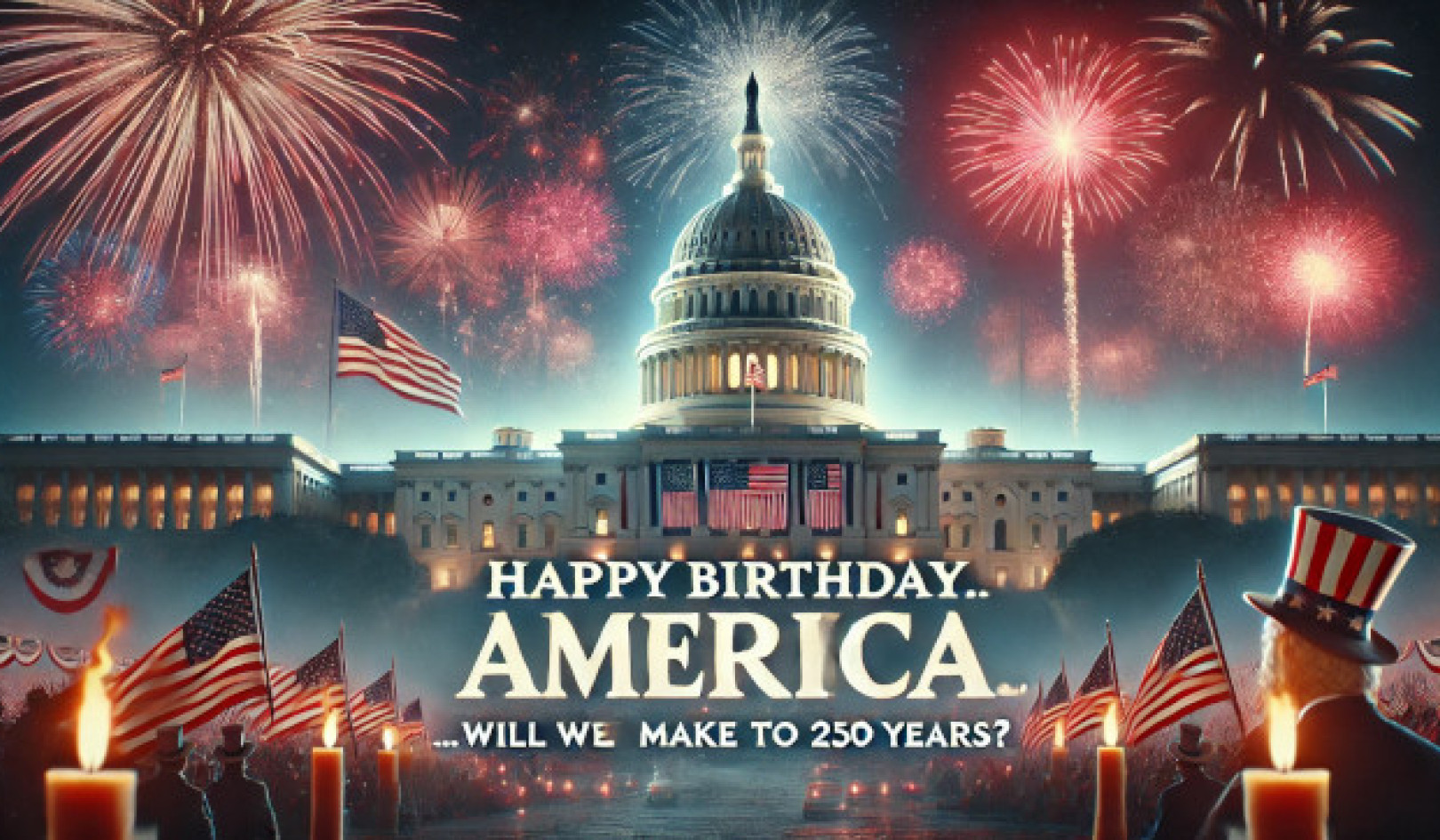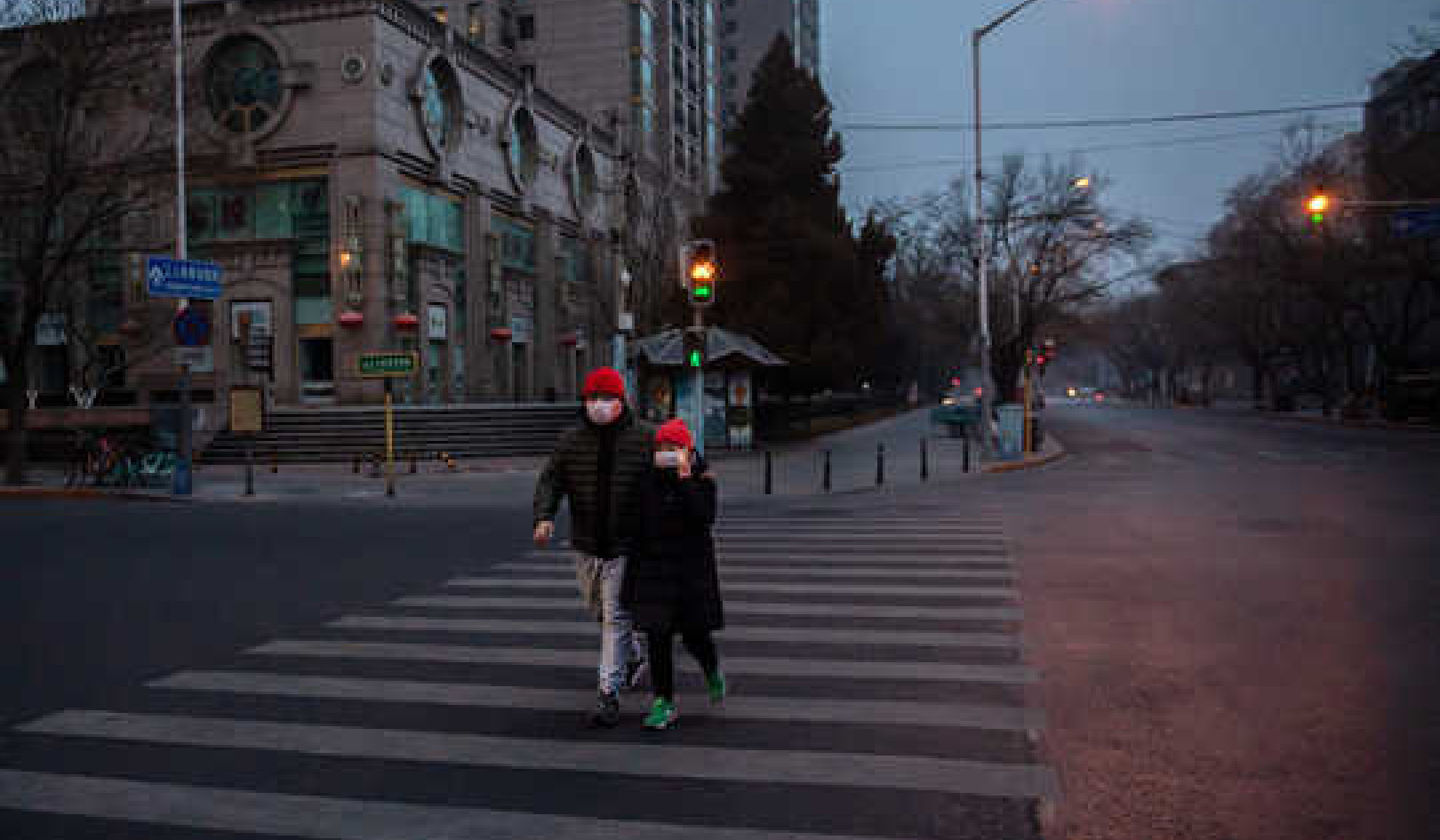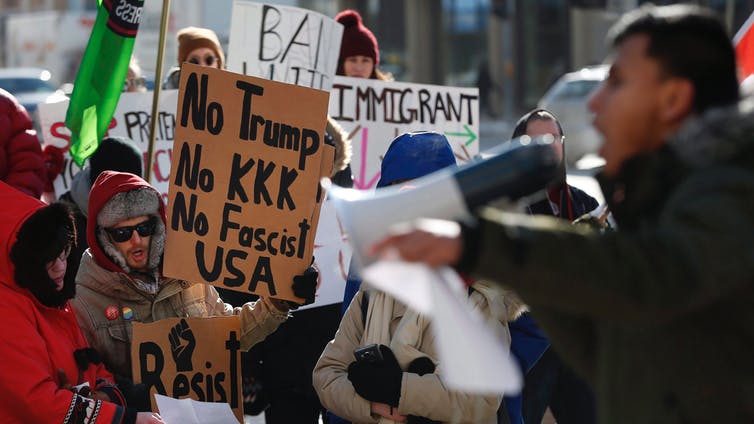 Countering extremist anti-immigrant and racist attitudes and recruiting in Manitoba requires new approaches. Here, on the right, Hazel Ismail, with No One Is Illegal, calls for Winnipeg to become a sanctuary city, Feb. 3, 2017. THE CANADIAN PRESS/John Woods
Countering extremist anti-immigrant and racist attitudes and recruiting in Manitoba requires new approaches. Here, on the right, Hazel Ismail, with No One Is Illegal, calls for Winnipeg to become a sanctuary city, Feb. 3, 2017. THE CANADIAN PRESS/John Woods
Late one afternoon this past summer, after leaving my Winnipeg office, I came across a poster that read: “When the house of cards comes crashing down, we’ll be ready. Will you join us?” In the background of this poster, the bridge that connects St. Boniface at the Forks was visible, while in the foreground, a masked soldier stood ominously with an assault rifle.
I thought that the poster might be from a theatre company for the Fringe Festival, and in the age of terror, I thought this production to be a novel one.
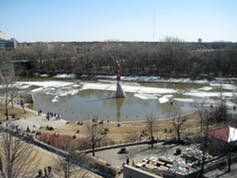 The Forks, Winnipeg, is where the Red River and Assiniboine River meet, and is an ancient and contemporary meeting place of significance for Indigenous commmunities. (Robert Linsdell/Flickr)
The Forks, Winnipeg, is where the Red River and Assiniboine River meet, and is an ancient and contemporary meeting place of significance for Indigenous commmunities. (Robert Linsdell/Flickr)
Unbeknownst to me, it was a recruitment poster for The Base, a U.S.-based neo-Nazi group. Within days, the Winnipeg Free Press had published an investigative piece that highlighted a chilling interview with a local Winnipeg member. The piece also said research shows “the presence of far-right extremists and members of hate groups in the ranks of the Canadian Armed Forces is a problem.”
Through both my own research in peace and conflict studies, and in my experiences listening to Winnipeg educators in a forum last winter, I believe that to confront and combat extremism, Manitoba needs new ways of engaging with young people that are sensitive to Manitoba’s social-political context.
We need to create opportunities where young people can share and critically reflect on their experiences with teachers and caring adults in schools and in their communities at large.
Such efforts might be built upon Brazilian educator Paulo Freire’s Education: the Practice of Freedom, in which he wrote: “To be human is to engage in relationships with others.” The role of human beings is not simply to be in the world but to engage with the world.
Young people targeted by extremists
As a researcher, I am curious to identify the social factors that cause extremism, which often leads to violence. Over the past decade, I have explored factors shaping extremism and how various social groups compete and collaborate to transform extremism and hate.
In my PhD research, I analyzed qualitative data gained from interviews with 49 community leaders in Winnipeg. These leaders identified inter-group animosity, as related to racism and inequality, as top social conflict issues in the city.
The causes of extremism globally reveals a trend: young people in schools and universities are often targeted by extremist recruiters who deploy a narrative of hate to motivate them.
Manitoba context
The poster and the subsequent news analysis about The Base recruiting in Winnipeg reinforced the reality that Manitoba is not an exemplary model of multiculturalism but a place that must seriously grapple with racism.
The Base’s call to take up arms comes on the heels of a number of disturbing and grim events in Winnipeg.
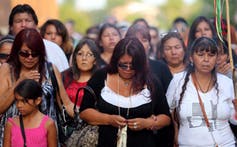 Tina Duck, centre, attends a vigil for her daughter Tina Fontaine at the Oodena Circle at The Forks in Winnipeg, Aug. 19, 2014. THE CANADIAN PRESS/Trevor Hagan
Tina Duck, centre, attends a vigil for her daughter Tina Fontaine at the Oodena Circle at The Forks in Winnipeg, Aug. 19, 2014. THE CANADIAN PRESS/Trevor Hagan
Last winter, three years after people gathered for a vigil at The Forks for teenager Tina Fontaine, many were outraged when the man accused of killing her was aquitted. Many highlighted how the trial revealed both racism in Canadian courts and deep failures of other institutions.
Last year, signs stating “It’s okay to be white” popped up at a number of educational institutions.
A whole Winnipeg school division closed due to online threats, a scenario eerily echoed recently during a school lockdown in Vita, Man., about 100 kilometres southeast of Winnipeg.
In 2016, the province saw high-profile terror activities in Aaron Driver’s allegiance to ISIS and his eventual demise. Driver was killed in Strathroy, Ont., in an RCMP altercation after he detonated a device in a taxi, but had lived in Winnipeg.
Dialogue with educators
I reached out to educators to hear about their experiences dealing with extremism in their classrooms. In a facilitated dialogue last February, I spoke with 12 educators from the Lord Selkirk and Louis Riel school divisions, and the University of Winnipeg Faculty of Education. Three things stood out from this dialogue.
Participants agreed that racism and anti-immigrant extremism were on the rise and manifesting in different forms, and said they were often uncomfortable addressing the matter in classrooms.
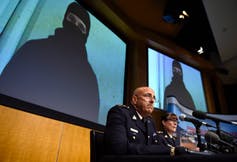 Video footage shows Aaron Driver, at an RCMP press conference, on Aug. 11, 2016 in Ottawa. THE CANADIAN PRESS/Justin Tang. Ottawa. THE CANADIAN PRESS/Justin Tang
Video footage shows Aaron Driver, at an RCMP press conference, on Aug. 11, 2016 in Ottawa. THE CANADIAN PRESS/Justin Tang. Ottawa. THE CANADIAN PRESS/Justin Tang
For example, a student wore a T-shirt with the “It’s okay to be white” slogan for couple of days until one educator intervened. Another educator shared her experience of interacting with Driver in an adult education class. Educators are left to themselves to deal with such situations.
Second, while the existing curriculum contains subjects like global issues and citizenship, it is seldom possible to discuss domestic hot-button matters such as race, religion and sex in the classroom because the educators aren’t obligated to do so and some of them are not comfortable discussing such topics in class.
Third, educators explained that multi-stakeholder support is needed to intervene comprehensively to counter extremism, because young people only spend part of the day in classrooms.
New approaches
The Manitoba social studies curriculum explains the concept of citizenship as “knowledgeable and engaged citizens” and is therefore an essential subject for kindergarten to Grade 12 students in age-appropriate ways.
There is also a strong focus on human rights, equality and responsibilities of citizens, as well as on anti-bias and anti-racism approaches and Aboriginal perspectives throughout the social studies curriculum. But racism is not covered as a subject or as content exclusively.
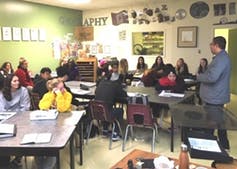 Author Kawser Ahmed visits a Grade 12 class at J.H. Burns Collegiate School in Winnipeg to discuss the dangers of radicalization and the importance of education. (Kawser Ahmed), Author provided
Author Kawser Ahmed visits a Grade 12 class at J.H. Burns Collegiate School in Winnipeg to discuss the dangers of radicalization and the importance of education. (Kawser Ahmed), Author provided
For example, Grade 11 Canadian history aims to teach students how to critically reflect on discrimination in a Canadian context. It emphasizes knowledge of the numbered treaties, the Indian Act and residential schools. It discusses content about “restrictions to Asian immigration,” the Chinese head tax and the impact of the American Civil War on Black immigration to Canada as well as Black loyalists — and how Canada admitted only a small number of refugee Jews between 1933 to 1939. But it doesn’t ensure comprehensive coverage of particular forms of racism in Canada.
The province’s Kindergarten to Grade 12 Aboriginal Languages and Cultures Manitoba Curriculum Framework of Outcomes discusses teaching Indigenous language learning alongside teaching about residential schools in grades 9-12 and treaties in grades 5-8. But teaching Indigenous languages isn’t mandatory, and is only done in some school contexts. The document encourages that “specific learning outcomes can … be integrated with other subject areas by other educators, Aboriginal and non-Aboriginal” but the extent to which that may happen is unclear.
In Grade 6, social studies learning outcomes include the reserve system and its impacts, treaties and Aboriginal rights in Canada from 1867 to the present.
Schools can’t do it alone
Our educators are uniquely positioned to prepare young people as they transition from school to university. But let’s understand that they can’t do it alone.
My search continues to explore ways to convince educators and broader communities to understand that as a society we are facing demands for new ways of forming relationships with young people, and new ways of teaching.
One idea is to bring the discussion on extremism and radicalization into classrooms — this is something I have started doing from time to time in partnership with teachers.
Communities are on the front line of activism and provide legitimate responses to conceptual dilemmas that often dog young people. A renewed relationship with teachers, adults and community leaders at large is needed based on trust and confidence.
About the Author
Kawser Ahmed, Instructor and SSHRC Post-Doctoral fellow at the Political Science department, University of Winnipeg
This article is republished from The Conversation under a Creative Commons license. Read the original article.

Related Books:
Caste: The Origins of Our Discontents
by Isabel Wilkerson
In this book, the author examines the history of racial oppression in America and explores how it continues to shape social and political structures today.
Click for more info or to order
Unbound: My Story of Liberation and the Birth of the Me Too Movement
by Tarana Burke
Tarana Burke, the founder of the Me Too movement, shares her personal story and discusses the impact of the movement on society and the fight for gender equality.
Click for more info or to order
Minor Feelings: An Asian American Reckoning
by Cathy Park Hong
The author reflects on her experiences as an Asian American and explores the complexities of racial identity, oppression, and resistance in contemporary America.
Click for more info or to order
The Purpose of Power: How We Come Together When We Fall Apart
by Alicia Garza
The co-founder of the Black Lives Matter movement reflects on her experiences as an activist and discusses the importance of community organizing and coalition building in the fight for social justice.
Click for more info or to order
How to Be an Antiracist
by Ibram X. Kendi
The author offers a guide for individuals and institutions to recognize and challenge racist beliefs and practices, and to actively work towards creating a more just and equitable society.



















